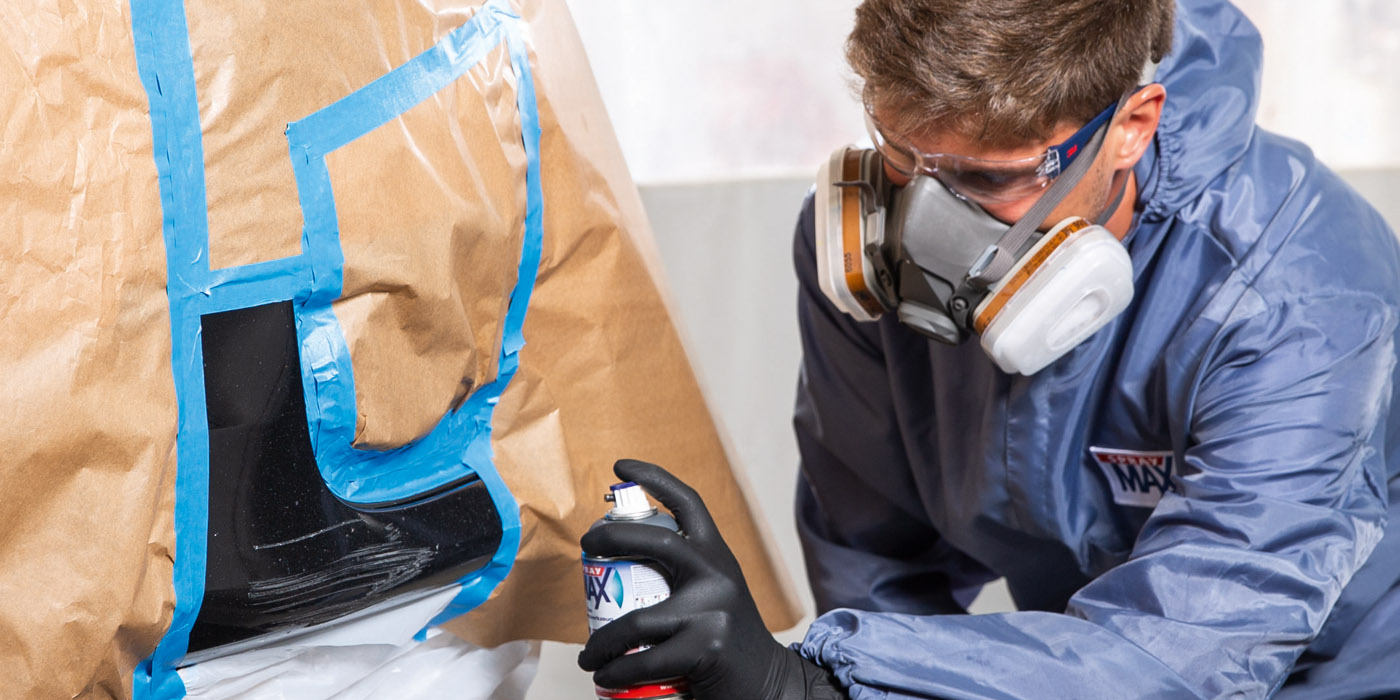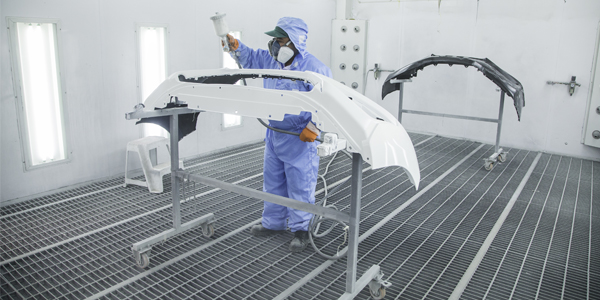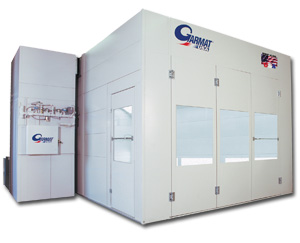
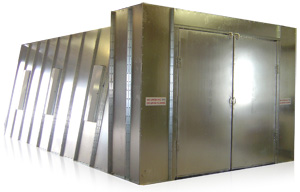
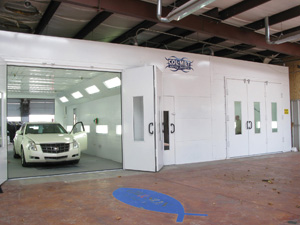
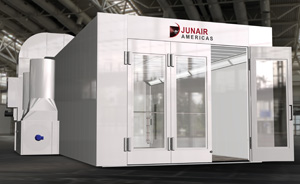
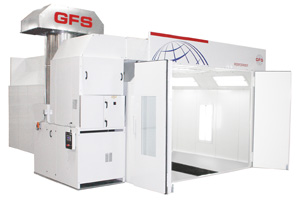
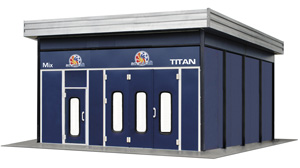
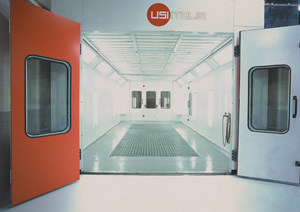
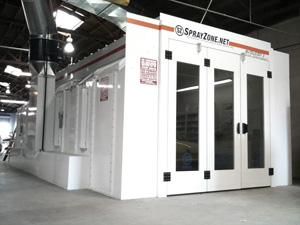 “A paint booth is the cornerstone of your business, so keeping it at its peak performance is extremely important,” says Debbie Teter with Garmat USA. “Having local service, support and accessibility to parts is paramount to keeping your shop up and running. As for the product itself, look for features that enhance productivity and keep operating costs down.”
“A paint booth is the cornerstone of your business, so keeping it at its peak performance is extremely important,” says Debbie Teter with Garmat USA. “Having local service, support and accessibility to parts is paramount to keeping your shop up and running. As for the product itself, look for features that enhance productivity and keep operating costs down.”
“Get the best value for your money,” adds Matt Barrow with A-Frame Spray Booths, Dallas. “Do your homework and look out for hidden costs.”
Consider useable features, of course (see chart on pg. 50, 52). “Look for something that is easy to assemble,” Barrow continues. “That is one thing that will not show up in the technical specifications. Look at the craftsmanship of the product and examine the product warranty.”
This is good, basic advice, but Jeremy Hagan, sales and marketing manager for AFC Finishing Systems, says body shops should look for a reputable spraybooth company with years of experience that can provide a list of customer references that may be contacted.
“It’s important that the spraybooth company is willing and able to provide quality service before, during and after the sale,” Hagan says.
Bill Reese, Central States Spray Booth Systems, Inc., says buyers should check their vendors to be sure they have listings from the proper testing laboratories, for instance, ETL and CTL.
“Does the booth meet NFPA33 and local code?” Reese asks. This is not only important in obtaining permits, it also means the product has been put through a battery of tests that ensure the buyer will be getting a safe, compliant, quality product and that both the equipment and the documentation (owners, technical manuals, etc.) comply with codes set forth by the federal government.
Companies with “listed” spraybooths (not just components) are prepared for random, unannounced inspections from the testing laboratory that has a mark on the equipment.
Good airflow based on the type of blower and blower efficiency (backward incline versus forward curve or tube axial fans) are key checkpoints, says Luigi Zucchet, vice president, USI of North America, Inc. He says a shop should look for air recirculation in curing (drying mode) to avoid reduced air flow in order to reach curing temperature.
“In addition, look for variable frequency drive (VFD) on the fan’s motor to save energy and avoid waste,” Zucchet says.
“In some cases,” says Dan Carrig, general manager at Shop-Pro Equipment, “a shop should ask, ‘Is a new paint booth needed or just additional capacity?’”
Whatever the answer, Carrig says the key questions to answer are what the booth’s productivity will be and what kind of return on investment it offers.
As long as your new spraybooth moves air at NIOSH-legal speeds (75 to 100 feet per minute,) the water will leave the paint film quickly enough to allow the shop to paint cars at a fair clip. With low-VOC paints, sufficient airflow is required, Carrig says.
The world is different now that low-VOC paints have replaced solvent-based paints, maintains Tyler Rand, president and owner of Spray-Tech/Junair. While the new paints cover with fewer coats – saving time and material – drying times are longer.
“Without the proper auxiliary air movement system, energy consumption and costs will be higher and the booth will become a bottleneck in the shop’s production capacity,” Rand says. “There will be higher chance of re-dos due to overcoating basecoats before they’re dry.” Rand added that shops without the ability to invest in new painting equipment will struggle to stay profitable.
“The biggest hurdle that shops face is how to get the waterborne paint to dry promptly, with minimal impact on the labor effort to get it to dry. Addition of an auxiliary air movement system will expedite dry times,” Rand says. “Having to move a tree of blowers is extremely time consuming, and ‘ceiling fan’ type dryers do not necessarily reach all of the areas that need to be dried on a vehicle.”
“Airflow is critical in order to properly flash off/dry waterborne coatings,” AFC’s Hagan agrees. This makes the use of some sort of air auxiliary movement (AAM) system in the booth critical in order to maintain production and keep cycle times low, he adds.
Download a Spray Booth Spec Chart – a listing of brands, models and specs
Location and Design
The location and design of a spraybooth will have a significant impact on the potential production capacity of a body shop, says Spray-Tech/Junair’s Rand. He recommends that the booth manufacturer and/or paint company review the facility and operations in order to help design the best layout for the shop so techs may reach the desired throughput.
“The design layout should consider the number and position of stalls allocated to body repair, panel repair, paint preparation, painting, re-dos and flow through,” Rand says, adding that drive-through booths are helpful in some building configurations, as are side-loading booths in others.
“Drive-through booths are great to keep all the work going in the same direction and reduce the amount of labor lost moving cars around,” says Jonathan Barrick, marketing manager for Global Finishing Solutions.
When positioning a spraybooth, A-Frame’s Barrow advises buyers to sketch out their workflow. “A drive-through booth is nice since it lets you use the area in front of the booth to set up work, and you have easy removal at the other end without moving cars around,” he notes.
Many firms offer personalized shop design services geared towards optimal shop space usage. Teter notes that Garmat USA’s design services department has earned an outstanding reputation by providing layout assistance to thousands of collision repair facilities.
“A layout should be prepared trying to have a flow in the process. Often that is not possible with the building,” Zucchet says.
Sometimes, it’s nice to move the spraybooth around. Shop-Pro’s mobile unit can be placed wherever it’s needed, when it’s needed, Carrig notes. For the techs, additional capacity and productivity increase the number of vehicles they can complete. For the owner, enclosing only the area being worked in requires a smaller motor. Since the unit requires no make-up air and uses – but doesn’t lose – the shop’s already heated and/or conditioned air, it can provide significant energy savings.
AFC’s Hagan recommends that shops work with their spraybooth company to determine the best placement of the spraybooth in their individual facility that will maximize work flow and eliminate bottlenecks. Most reputable spraybooth companies will work with each individual customer to provide a recommended shop layout that works best for their specific business.
Moving Air
Next to moving cars, moving air is a key metric. “It’s critical that turbulence is eliminated in the paint mode in order to keep dirt off of the vehicle,” Hagan says.
The downdraft booth is probably the best airflow configuration on the market. Air is pushed down through filters (positive pressure) or it’s pulled down through by an exhaust fan (negative pressure). The air moves down into the trench, filtered and exhausted outside. A downdraft booth has a trench or trenches in the floor, which the vehicle straddles, and the air is pulled around it and down through the trench. This gives overspray a quick exit and helps if the tech is painting only a section of a car and the rest is taped off with plastic.
“For the best paint finish, a downdraft does the work,” says Napoleon Garcia, sales director at Spray- Zone.net.
The side downdraft is probably the easiest to install. It requires no digging up of the floor, and air is pushed down through the filters by either positive pressure or negative pressure and then is pulled to the side of the booth where it’s then filtered and exhausted outside.
Semi-downdraft is economical and reliable. Air is pushed down through the filters in the front of the booth by either positive pressure or negative pressure and then it’s pulled horizontally over the vehicle toward the back of the booth and then filtered and exhausted outside.
Cross-flow booths used to be popular but have largely been replaced by more efficient designs. Their big selling point, however, is that they’re very economical. That factor alone makes them a good choice for some applications.
Whether you go with a downdraft or crossdraft spraybooth, you’re buying a system that forces air to move across the car…either from top to bottom in a downdraft or from front to rear in a crossdraft booth.
With the new paints, paint booths need to be able to remove overspray more quickly than in the past since spray guns now put out a lot more volume of product, Global Finishing’s Barrick says. “Cure options are also important since shops may have a wide range of products to do different types of repairs,” he adds.
Any auxiliary air movement devices disturb linear airflow by interrupting the directional flow and moving the extra air in another plane. The effect is much like smoke blowing over a car in a wind tunnel. With that boundary layer of slow air right next to the car’s surface, it will seem like the smoke doesn’t touch the car. Retrofit auxiliary air movement devices interrupt air movement in one direction and create surface turbulence. That gets the water component to leave the paint film and speeds drying.
“Intake media should be 90 percent efficient at collecting 10 micron particles,” Barrick says.
Garmat USA’s Teter recommends high-quality ceiling filters with knife edge closures to ensure a filter particulate capture rate of 99.9999 percent.
“At 99.9999 percent efficient, the top-quality filter media will allow less than 20 particles at 10 microns to pass through on each paint job (a human hair is about 100 microns),” she says. By contrast, a similar filter media rated at 99.99 percent efficient will allow 2,000 particles at 10 microns to pass through. “Paint booths with positive pressure need to have doors that completely seal,” Teter adds.
The only sure-fire way to keep dust and dirt out of a paint job is with a pressurized spraybooth, A-Frame’s Barrow says. He notes that many booths, especially at the entry level, aren’t pressurized. Cost, about $4,000 or $5,000, is one reason. “But it’s worth the money if you want to keep dust and debris out,” he states.
“Use quality intake filters and door gaskets/seals,” AFC’s Hagan says. It’s also important to note here that most dirt is brought into the spraybooth by the operator (on himself, on the car, etc.). “Good housekeeping practices are extremely important in order to keep the dirt out of the booth in the first place,” he says, adding that proper airflow (eliminate turbulence!) will help reduce many of the issues associated with dirt in the booth by not allowing dirt to be picked up off of the floor or other surface and “swirl” through the booth.
“A spraybooth should be a downdraft with a wider pit where air goes out to reduce turbulence,” USI’s Zucchet says. He says shops should try to minimize the concrete floor area since that’s a major source of contamination.
Zucchet likes to see microfilter ceiling filters sealed against the booth ceiling rather than just leaning on it. “The booth is only one factor to keep dirt out,” he cautions. “Vehicle prep, clean compressed air and having the operator wear a suit are musts to avoid contamination.”
The result, Zucchet says, is a tech’s ability to obtain a clean paint job without the need to buff or remove dirt from the painted car.
“Cleaner paint jobs are essential,” Teter says, adding that filtration and airflow are two important considerations for achieving a higher quality paint job. “There is a difference between finish detailing an entire vehicle for three to six hours or polishing for 10 minutes,” she notes. That little difference is a significant increase in productivity. Fast evacuation of overspray ensures a clearer and cleaner environment.
The keys to keeping dirt out of a recirculation booth, Shop Pro’s Carrig says, are quality of the filtration system and air flow pattern realized. “That is key to keeping contaminants from interfering with the quality of the paint job,” he says.
Other Concerns
AFC’s Hagan says a spraybooth’s interior dimensions should be large enough to provide the painter with plenty of work space, especially given the high number of trucks and SUVs on the road today. Lighting is also important. This includes not only the right quantity of light fixtures but also the correct placement of fixtures to eliminate dark spots or shadows, Hagan says.
A-Frame’s Barrow is wary of foreign-made products. He says it can take weeks to get a replacement for a damaged panel shipped in from China.
“If the cars are prepared properly and cured completely in the booth, a shop can run five to six paint jobs per day,” USI’s Zucchet says.
Hagan feels that using a high quality spraybooth with a cure cycle makes it realistic to get six to eight cars through a booth in an eight-hour day. “This number will vary greatly, however, depending on several factors, including the efficiency of the painter, workflow in the shop, paint system used, etc.,” he says.
In the end, watch your costs. In addition to equipment costs, Gene Ivey, Profit Solutions Equipment Company, notes there will be permit costs, fire suppression requirements, freight, and a host of installation costs for things such as mechanical erection, electrical wiring, roof opening and closing, air lines and the installation of new compressed air treatment and running fuel to the burner.
Lighting is also a factor. Horizontal positioned, color-corrected lighting fixtures improve a painter’s work space. The horizontal orientation eliminates shadow on critical color matches.
Barrick says energy efficiency should be one of the most important issues to consider. “Recirculation during cure mode, variable frequency drives and an economy mode should all be part of the spraybooth package,” he says.
Whatever the choices, price alone is not the best criteria for judging any capital equipment purchase. “Look at the overall investment as it pertains to the business,” Garmat USA’s Teter advises.
A paint booth will be a significant part of any shop’s operating expenditures. Considering features that help reduce expenses will actually negate part of the purchase price. “Increasing production, saving energy and simplifying maintenance procedures should all be taken into consideration,” Teter concludes.
Download a Spray Booth Spec Chart – a listing of brands, models and specs
Curt Harler is a Cleveland-based freelance writer specializing in the automotive, technology and environmental areas. He’s the recipient of the International Communications Association Industry Achievement award for his writing. You can reach him at [email protected].










